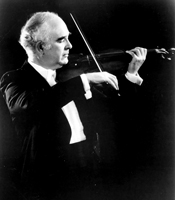home | metro silicon valley index | music & nightlife | preview

Sure hand: Guest conductor Joseph Silverstein led Symphony Silicon Valley over the weekend.
Doubling Down on Brahms
Guest conductor Joseph Silverstein and Symphony Silicon Valley solve the problems of Brahms' 'Double'
By Scott MacClelland
POPULAR TASTE has anointed the four concertos by Johannes Brahms as fully one-quarter of the great concertos from the 19th century. Yet in each the composer created more problems than he solved. In the last of them, the "Double" for violin and cello, the first movement (in particular) is afflicted with interrupted pacing and awkward phrasing. Of course, interpreters of this work (as with the other three) can go a long way toward smoothing over the inherent glitches and seducing an audience with its grandeur.
This is just what happened Sunday afternoon when violinist Axel Strauss, cellist Mark Kosower and, in significant measure, conductor Joseph Silverstein presented the Brahms Double at the California Theatre. Kosower tackled the big solo cadenza that opens the piece (right after a terse orchestral declamation) like a walk in the park. In its technical and rhetorical importance, this very solo causes many a featured cellist to suffer a cold sweat of anticipation. Not so Kosower, who was cucumber cool in introducing himself and setting the tone for what would follow. Strauss followed, of course, and formed a duo with Kosower that carried the work as one man.
Not that they were without their individuality, however, making the performance that much more riveting. One attends many a concert in the vain hope that such will be the case. Here it was possible, even easy, to savor each moment for its expressive nuance. And to make the best sense of the whole, a veteran insider like Silverstein proved invaluable. (All the top concertmasters know the scores of their repertoire virtually as well as professional conductors—and sometimes better.) If the soloists provided the crucial individual character, the man on the podium constructed an authoritative portrait of the formidable composer in all his haughty arrogance.
While the Brahms punctuated the program, and the fifth Symphony Silicon Valley season, it did so after a treasury of excellent orchestral playing in Stravinsky's similarly arrogant Symphony in Three Movements. The work recycles material composed originally for possible use in Hollywood movies. But as usual, Stravinsky's music doesn't lend itself to mixed media—Petrushka is a notable exception—as much as it loves itself. This piece doesn't even love audiences except through the players, who do get a bowlful of cherries, including abundant cameos and intimate asides. They, in turn, loved the music back, and that's what brought the reading to life and made its case. Again, Silverstein was the right man for the job.
Ahead of the Stravinsky was Haydn's Symphony 102 in B-flat, whose final movement deports some of the composer's cheekiest and most avant-garde inventions and surprises. Silverstein made sure to etch them all their winking wit. However, he might have played the second movement less dry-eyed and more dewy. In some hands, the piece (which is drawn from the composer's Piano Trio in F-sharp Minor) is a coy flirtation, in others almost weepy with understated tragedy. (Since Haydn never wears his feelings on his musical sleeve it offers a rare glimpse into the man's emotions.)
Silverstein opened the program with a splendid fanfare (for full orchestra) by timpanist Robert Erlebach, now completing his 40th year in a tenure that began with the erstwhile San Jose Symphony.
Send a letter to the editor about this story.
|
|
|
|
|
|